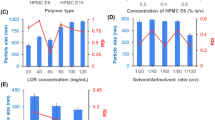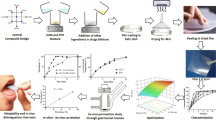Abstract
The present investigation was undertaken with the objective of formulating orodispersible film(s) of the antidepressant drug tianeptine sodium to enhance the convenience and compliance by the elderly and pediatric patients. The novel film former, lycoat NG73 (granular hydroxypropyl starch), along with different film-forming agents (hydroxypropyl methyl cellulose, hydroxyethyl cellulose, and polyvinyl alcohol), in addition to three film modifiers; namely, maltodextrin, polyvinyl pyrrolidone K90 and lycoat RS780 (pregelatinized hydroxypropyl starch) were evaluated. Eight formulae were prepared by the solvent-casting method; and were evaluated for their in vitro dissolution characteristics, in vitro disintegration time, and their physico-mechanical properties. The promising orodispersible film based on lycoat NG73 (F1); showing the greatest drug dissolution, satisfactory in vitro disintegration time and physico-mechanical properties that are suitable for orodispersible films, was evaluated for its bioavailability compared with a reference marketed product (Stablon® tablets) in rabbits. Statistical analysis revealed no significant difference between the bioavailability parameters (C max (ng/ml), t max (h), AUC0–t (ng h ml−1), and AUC0–∞ (ng h ml−1)] of the test film (F1) and the reference product. The mean ratio values (test/reference) of C max (89.74%), AUC0–t (110.9%), and AUC0–∞ (109.21%) indicated that the two formulae exhibited comparable plasma level-time profiles. These findings suggest that the fast orodispersible film containing tianeptine is likely to become one of choices for acute treatment of depression.




Similar content being viewed by others
REFERENCES
Cilurzo F, Cupone IE, Minghetti P, Selmin F, Montanari L. Fast dissolving films made of maltodextrins. Eur J Pharm Biopharm. 2008;70:895–900.
Patel PB, Gupta GD. Fast dissolving drug delivery systems: an update. Pharminfo.net, 2006; 4.
Keith S. Advances in psychotropic formulations. Prog Neuropsychopharmacol Biol Psychiatry. 2006;30:996–1008.
Gaisford S, Verma A, Saunders M, Royall PG. Monitoring crystallization of drugs from fast-dissolving oral films with isothermal calorimetry. Int J Pharm. 2009;380:105–11.
Shimoda H, Taniguchi K, Nishimura M, Matsuura K, Tsukioka T, Yamashita H, et al. Preparation of a fast dissolving oral thin film containing dexamethasone: a possible application to antiemesis during cancer chemotherapy. Eur J Pharm Biopharm. 2009, doi:10.1016/j.ejpb.2009.08.010.
Mashru RC, Sutariya VB, Sankalia MG, Parikh PP. Development and evaluation of fast-dissolving film of salbutamol sulphate. Drug Dev Ind Pharm. 2005;31:25–34.
Dinge A, Nagarsenker M. Formulation and evaluation of fast dissolving films for delivery of triclosan to the oral cavity. AAPS PharmSciTech. 2008;9:349–56.
Ahmed MG, Charyulu RN, Harish NM, Prabhu P. Formulation and in-vitro evaluation of chitosan films containing tetracycline for the treatment of periodontitis. Asian J Pharm. 2009;3:113–9.
Prissaux X, Josh A, Francois A, Lefevre P. Evaluation of a novel modified starch polymer in an easy to formulate thin film drug delivery system and comparison with some marketed formulations. AAPS 2007. Available at: (www.roquette-pharm.com). Accessed July 2009.
Defrance R, Marey C, Kamoun A. Antidepressant and anxiolytic activities of tianeptine: an overview of clinical trials. Clin Neuropharmacol. 1988;11:S74–82.
Khedr A. High-performance liquid chromatographic stability indicating assay method of tianeptine sodium with simultaneous fluorescence and UV detection. J Chromatogr Sci. 2007;45:305–10.
Uzbay TI, Kayir H, Ceyhan M. Effects of tianeptine on onset time of pentylenetetrazole-induced seizures in mice: possible role of adenosine A1 receptors. Neuropsychopharmacology. 2007;32:412–6.
Muniz PS, Nardi AE. Refractory pain-depression syndrome treated with tianeptine: a case report. Aust N Z J Psychiatry. 2004;38:176–82.
Uzbay TI. Tianeptine: potential influences on neuroplasticity and novel pharmacological effects. Prog Neuropsychopharmacol Biol Psychiatry. 2008;32:915–24.
Gorle AP, Gattani SG. Design and evaluation of polymeric ocular drug delivery system. Chem Pharm Bull. 2009;57:914–9.
Ammar HO, Ghorab M, El-Nahhas SA, Kamel R. Polymeric matrix system for prolonged delivery of tramadol hydrochloride, part I: physicochemical evaluation. AAPS PharmSciTech. 2009;10:7–20. doi:10.1208/s12249-008-9167-0.
Rawas-Qalaji MM, Simons FE, Simons KJ. Fast-disintegrating sublingual tablets: effect of epinephrine load on tablet characteristics. AAPS PharmSciTech. 2006;7:E1–7.
Cohen JL, Hubert BB, Leeson LJ, Rhodes CT, Robinson JR, Roseman TJ, et al. The development of USP dissolution and drug release standards. Pharm Res. 1990;7:983–7.
Kim JO, Choi JY, Park JK, Kim JH, Jin SG, Chang SW. Development of clindamycin-loaded wound dressing with polyvinyl alcohol and sodium alginate. Biol Pharm Bull. 2008;31:2277–82.
Miyazaki S, Nakayama A, Oda M, Takada M, Attwood D. Drug release from oral mucosal adhesive tablets of chitosan and sodium alginate. Int J Pharm. 1995;118:257–63.
Mannila J, Järvinen T, Järvinen K, Tarvainen M, Jarho P. Effects of RM-beta-CD on sublingual bioavailability of delta9-tetrahydrocannabinol in rabbits. Eur J Pharm Sci. 2005;26:71–7.
Mannila J, Järvinen T, Järvinen K, Tervonen J, Jarho P. Sublingual administration of delta9-tetrahydrocannabinol/beta-cyclodextrin complex increases the bioavailability of delta9-tetrahydrocannabinol in rabbits. Life Sci. 2006;78:1911–4.
Moffat A, Osselton MD, Widdop B, Galichet LY. Clarke's Analysis of Drugs and Poisons, electronic version. 3rd ed. London: Pharmaceutical Press; 2004.
Gaulier JM, Marquet P, Lacassie E, Desroches R, Lachatre G. High-performance liquid chromatographic determination of tianeptine in plasma applied to pharmacokinetic studies. J Chromatogr. 2000;748:407–14.
British Pharmacopoeia III, Her Majesty's Stationery Office Ltd., London, 2003. pp. 2598–2599
Arora P, Mukherjee B. Design, development, physicochemical, and in-vitro and in-vivo evaluation of transdermal patches containing diclofenac diethylammonium salt. J Pharm Sci. 2002;91:2076–89.
Nafee NA, Ismail FA, Boraie NA, Mortada LM. Mucoadhesive buccal patches of miconazole nitrate: in vitro/in vivo performance and effect of ageing. Int J Pharm. 2003;264:1–14.
Chen L, Imam SH, Gordon SH, Greene RV. Starch-polyvinyl alcohol crosslinked film performance and biodegradation. J Environ Polym Degrad. 1997;5:111–7.
Katz MG, Wydeven T. Selective permeability of PVA membranes. II. Heat-treated membranes. J Appl Polym Sci. 1982;27:79–87.
Guidance for Industry, Bioanalytical Method Validation, U.S. Department of Health and Human Services Food and Drug Administration. 2001.
Chakravorty S, Hariharan V. Mouth dissolvable and meltable, and water dispersible delivery formulation USPC Class: 514242 IPC8 Class: AA61K3153FI.
Korsmeyer RW, Gurny R, Doelker E, Buri P, Peppas NA. Mechanisms of solute release from porous hydrophilic polymers. Int J Pharm. 1983;15:25–35.
Diaz del Consuelo I, Falson F, Guy RH, Jacques Y. Ex vivo evaluation of bioadhesive films for buccal delivery of fentanyl. J Control Release. 2007;122:135–40.
Daniel JZ, Michael DR, Albert H. Edible film formulations containing maltodextrin, 2004; US patent: 6,740,332.
Prissaux X, Josh A, Dussautois C, Le Bihan G, Lefevre P. Functional advantages of a novel modified starch over HPMC in aqueous film coating of tablets. AAPS 2006. Available at: (www.roquette-pharm.com). Accessed July 2009.
Zou J, Di B, Wu CY, Hu Q, Li JH, Zhu Y, et al. Pharmacokinetic and bioequivalence comparison of a single 100-mg dose of cefteram pivoxil powder suspension and tablet formulations: a randomized-sequence, open-label, two-period crossover study in healthy Chinese adult male volunteers. Clin Ther. 2008;30:654–60.
ACKNOWLEDGEMENT
The authors are grateful to Professor Dr. Samia Nour, Professor of Pharmaceutics and Industrial Pharmacy, Faculty of Pharmacy, Cairo University for revising the manuscript.
Author information
Authors and Affiliations
Corresponding author
Additional information
An erratum to this article can be found at http://dx.doi.org/10.1208/s12249-010-9524-7
Rights and permissions
About this article
Cite this article
El-Setouhy, D.A., El-Malak, N.S.A. Formulation of a Novel Tianeptine Sodium Orodispersible Film. AAPS PharmSciTech 11, 1018–1025 (2010). https://doi.org/10.1208/s12249-010-9464-2
Received:
Accepted:
Published:
Issue Date:
DOI: https://doi.org/10.1208/s12249-010-9464-2




